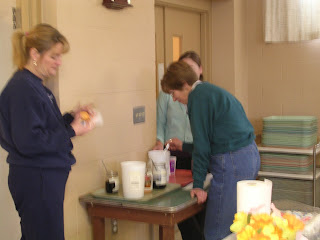







The word Pysanka means in the Ukranian language, an egg that has been decorated with a wax resist (batik) type method.
This art form goes back into antiquity when ancient people worshipped the sun. Why not worship the sun? In a land with the cold and barren darkness of winter, it was the sun that heralded the arrival of spring, new birth, new life! In the Ukraine, eggs were chosen for sun worship ceremonies, the yolk representing the sun and the white, the moon. Just as the earth seemed devoid of life in the winter and bursting forth with newness in the spring, the egg, seemed to be like a stone until a new life appeared in the form of a chick. Because new life came from an egg, people came to believe they had the power to help them in their daily lives. They would be buried in fields and mangers, given as gifts to ensure health and prosperity, ward off evil, or make fertile. The designs on the eggs were based on ancient forms and legends by an ancient people who respected and revered nature.
With the advent of Chiristianity new meanings were added to old symbols and the early missionaries incorporated the art form into the Christian belief of the local people, bringing more to a knowlegde of the love of Christ. The most important holiday in the Ukraine is Easter, which is more than a three day period but lasts a full forty days starting the first day of Lent. On Mondays, Wednesdays and Fridays, fast days, no eggs, meat or dairy are eaten after the Ash Wednesday church service. As well as physical and spiritual cleansing, the family would also emback on a spring cleaning of the house, the home would be cleansed in preparation for Easter as well. Any one who had had a disagreement with a neighbor during the previous year would make sure it was amended during this time. If the family could afford it new clothes would be made or purchased, otherwise they would at least get new shoelaces!
In this state of mind, a woman would make Pysanky. Before they could be made, one was to be in a spiritual state of mind. The previous day was to have been spent peacefully, avoiding gossiping, dealing with the family patiently and preparing a good dinner. They were to be made at night after the children were asleep. Only the women in the family could work together, no one else was allowed to peek so that the goodness from the household would be transferred onto the designs and evil would be pushed away. Making Pysanka was not a social but rather a mystical event. Fresh eggs were gathered from hens where a rooster was in residence, for, according to belief, if non fertile eggs were used there would be no fertility in the home. Different blessings were asked for each egg so that their good wishes would travel with the pysanky. As one practices, technical talent develops in all artists, but it is the power and love which the egg conveys that is what is important. the process took several evenings to finish, usually about sixty eggs, for a family, by Holy Thursday. One or two of the eggs would be given to the priest. Three or four were taken to the cemetary and placed on the graves of the family. Then to fifteen were given to small children and God-children. Ten to fifteen would be exchanged by unmarried girls with the eligible young ment in the community. Several were saved to place in the coffin of loved ones who might die during the coming year. Several were saved to keep in the home for protection from fire and storms. Two or three were placed in the trough where the animals ate, so that they would have many young. At least one egg would be place under a bee hive to ensure a good harvest of honey. One was saved for each grazing animal to be taken out to the fields with the shepherds in the spring.
The egg dyes are non edible and the eggs are not hard boiled. You work on them either raw, or blown. I prefer working on them raw with the egg still in the shell. if they are stored so that air can circulate all around them, the insides eventually evaporate and become hardened. I have some of the first eggs I have ever made from back in 1976 still. I buy my supplies from the Ukrainian Gift Shop www.ukrainiangiftshop.com. There are other places you can purchase the special tool, "kistka", and the dyes. I buy bees wax from a local bee keeper. I keep my dyes in mason jars under my kitchen sink all year around. My daughter and I make eggs whenever we feel the "urge" just as my mother as I did before she passed away. Precious times. Inspiring symbolism.